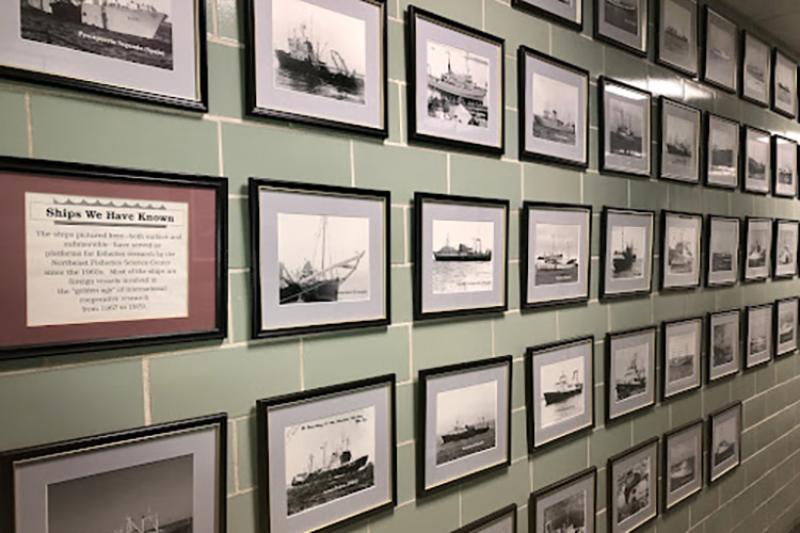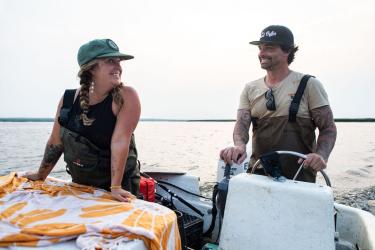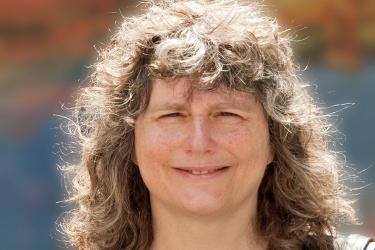The ships represented in the gallery, both surface and submersible, have served as platforms for research by the Northeast Fisheries Science Center since the 1960s. Most of the ships are foreign vessels involved in the period of international cooperative research from 1967 to 1979.
The 1950s and 60s brought increasing numbers of foreign vessels with new technologies such as enhanced navigation and fish finders to the highly productive fishing grounds of the Northwest Atlantic. This led to surveillance by what is now NOAA Fisheries to determine the potential effects on U.S. fisheries. For many species the harvest rate was too high to sustain natural production. When too many fish are removed from the ocean, the imbalance impacts the entire ecosystem. Overfishing also impacts the availability of a protein-rich food source and the economy, either directly or indirectly, as many people work in the fishing industry.
The era of international cooperative vessel surveys was a huge undertaking for the Science Center during the US-USSR Joint Fisheries Research in the Northwest Atlantic, the International Commission for the Northwest Atlantic Fisheries (ICNAF) and the Marine Resources Monitoring, Assessment and Prediction Program (MARMAP) regime, and prior to the Magnuson–Stevens Act (MSA). The US-USSR research project was a cooperative program under a 1967 bilateral fisheries management agreement to develop a research vessel survey program to provide accurate biomass estimates and manage harvests. Over the 10-year span, the program conducted roughly 50 cooperative research cruises from Nova Scotia to Cape Hatteras. Cruise objectives included comparing zooplankton sampling gear and techniques, comparing the fishing power of trawls, gear comparison, trawl testing, hydroacoustic investigations, and biological studies.
The US-USSR project also served as a road map for ICNAF, which formed in 1949. This commission was one of the first regional fisheries management bodies to play a major role in the assessment and management of fish stocks outside of national jurisdictions in the Northwest Atlantic. The eight countries involved in international research cruises with the Science Center were members of this commission. ICNAF developed a substantial cooperative program to research the early life history of herring stocks in Georges Bank and the Gulf of Maine. Thirty-nine larval herring surveys took place between 1971 and 1979, resulting in a substantial database.
MARMAP is another prime example of international collaboration between the United States and other nations. This ecosystem monitoring program ran from 1977 to 1988 and collected biological and environmental data from surveys in waters from Nova Scotia to Cape Hatteras. The United States, Poland, the USSR, the German Democratic Republic, the Federal Republic of Germany, France, Canada, and Japan all provided platforms and scientists. Eighty-one cruises took place during the MARMAP decade.
The MSA was enacted in 1976 to govern marine fisheries management in U.S. federal waters. Much of the data and analyses derived from the above-mentioned research programs were instrumental in demonstrating the issues that faced our resource. Prior to the MSA, international waters began 12 miles from shore and fish stocks were being depleted by unregulated foreign fishing fleets. The law extends the U.S. jurisdiction to 200 nautical miles and fosters long-term biological and economic sustainability of marine fisheries.
From 1963–1977, Science Center staff took part in more than 200 at-sea research projects on 40 different vessels, with vessels from eight nations. The “Wall of Ships” was a way of visually documenting those surveys. Not all of the ships docked in Woods Hole, but all were involved in joint cruises with Center scientists on board. Note that not all of the vessels that served as platforms are represented, and there may have been additional cruise objectives not referenced here.
Let’s take a look at one ship from each of the eight participating countries. Images of the remaining ships pictured on the wall can be found in our photo gallery.
Albatross IV
Specially designed to conduct fisheries and oceanographic research, the 187-foot Albatross IV was the first research stern trawler built in the United States. The vessel was commissioned in 1963 and spent much of its nearly 46-year career conducting resource surveys to assess the health and population structure of finfish and scallops on the Northeast continental shelf. It also conducted marine mammal surveys and studies of plankton and larval fish abundance. Many cruises in the 1960s and 1970s represent cooperative studies with the foreign vessels highlighted in this story. The ship was decommissioned in 2008, marking the end of an era for U.S. research ships that bear the name Albatross.
Learn more about this ship and its research
Anton Dorhn
The former West German R/V Anton Dorhn, a 62.3-meter steam powered side trawler, was notably the first fishery research vessel belonging to the Federal Republic of Germany. The ship participated in 14 international cooperative cruises with the Science Center in the 1970s. Missions included bottom trawl, MARMAP, hydrographic, ichthyoplankton, and ICNAF larval herring surveys.
Learn more about this ship and its research
Belogorsk
The former USSR R/V Belogorsk was a 250-foot converted factory stern trawler that participated in 26 joint research cruises over a period of 6 years in the mid to late 1970s. Cruise objectives included ICNAF larval herring, hydrographic, bottom trawl gear comparison, plankton, day/night catchability, and MARMAP surveys.
Cryos
The French R/V Cryos participated in six cooperative cruises over a 5-year period in the 1970s. The Albatross IV, Delaware II, Walther Herwig (Germany) and Blesk (USSR) vessels took part in the international cooperative cruises alongside the Cryos in Georges Bank, the Gulf of Maine, and off Western Nova Scotia. Cruise operations included bottom trawl, ICNAF larval herring dispersion, plankton, and squid surveys.
Learn more about this ship and its research
Kaiyo-Maru
The Japanese R/V Kaiyo-Maru, a stern trawler, participated in one joint cruise with the Science Center. The 1982 mission was organized by Canada, Japan, and the United States to answer ecology questions of the commercially important squid species, Illex illecebrosus. This cruise supported the MARMAP objective of capturing plankton and hydrographic data, along with using a midwater trawl to target squid in the Gulf Stream off New England and Nova Scotia.
Learn more about this ship and its research
Pescapuerta Segundo
The Spanish F/V Pescapuerta Segundo, was a 145-foot tuna trawler which participated in one cooperative cruise with the Science Center in 1989. The survey was designed to evaluate different Spanish commercial trawls in terms of bycatch of both longfin and shortfin squid. The vessel also conducted cod-end mesh selectivity experiments and acquainted U.S. scientists and a fishing industry observer with the Spanish squid fishing operation, and collected hydrographic and MARMAP data.
Learn more about this ship and its research
E.E. Prince
The E.E. Prince was a 40-meter steel deep-sea stern trawler of the Canadian Department of Fisheries and Oceans Atlantic fisheries research vessel fleet, homeported in Halifax, Nova Scotia. The E.E. Prince participated in eight cooperative surveys with the Science Center over a 6-year span, including ICNAF larval herring, scallop and bottom trawl surveys.
Learn more about this ship and its research
Wieczno
The Polish R/V Wieczno was a 61-meter side trawler which contributed greatly to Polish-American fisheries research with the Science Center in the Northwest Atlantic waters over a period of 10 years. Cruise objectives included apex predator, bottom trawl, hydrography, ICNAF larval fish research, gear comparison, pelagic trawl, plankton, and predator/prey surveys.











